Is sustainability the new black?
James Rigg, the CEO of Trojan Electronics, a developer of circular solutions for electrical manufacturers and retailers, discusses how the adoption of such a pricing structure could aid consumers in making more responsible decisions while also assisting stores in becoming more sustainable

Register to get 1 free article
Reveal the article below by registering for our email newsletter.
Want unlimited access? View Plans
Already have an account? Sign in
Recently, a German supermarket raised the prices of a selection of its products to reflect their real cost on people’s health and the environment. The awareness-raising campaign week was organised in collaboration with academics from the University of Greifswald and the Nuremberg Institute of Technology. It was inspired by consumer researchers’ conviction that supermarket price tags in no way accurately represented the true environmental or long-term health costs of producing the foodstuffs and getting them onto store shelves.
James Rigg, the CEO of Trojan Electronics, a developer of circular solutions for electrical manufacturers and retailers, discusses how the adoption of such a pricing structure could aid consumers in making more responsible decisions while also assisting stores in becoming more sustainable. Additionally, he discusses how consumers are far more environmentally conscious than retailers and are willing to pay extra for sustainable goods.
How do you think customers are viewing sustainability amid the rising cost of living, the energy crisis, and inflation?
I think consumers are way ahead of retailers and manufacturers when it comes to what they want from sustainability and circularity. I think consumers want a product that is of good quality and have high confidence that if they buy something that is refurbished, it will arrive as it says on the packaging. The survey that we conducted at Trojan found that 71% of people in the survey said that they considered the environmental impact of the goods that they purchased. So people are absolutely thinking about the impact of the product that they are buying and how they can make a difference, but at the same time, they’re financially laid off. People have price points, and not everybody can spend more just to be luxurious. So we’ve seen two things happen here: in a new product, we’re seeing people spending the same amount of money that they would have done maybe three years ago.
So let’s say they spent £199 on a washing machine three years ago; they’ll spend the same money now, but they’re buying a cheaper brand, the washing machine has a slower spin, or it has a smaller drum size. So what we’re seeing is that since people can’t continue to buy the product they would have bought, they’re buying a product that is not as good as what they want. That’s customer type one: people buying brand new, so they have to trade down in quality for the same price.
We’re also seeing another customer type who is trading up by buying a refurb. So many manufacturers and retailers think that refurb is a substitution for the new product. For instance, if a premium product is £599 new but it’s £399 refurb, people are switching from having a lower-quality product to a high-quality product for the same price, and that’s always seen in consumers. They want to be able to get better quality at a price that they can afford. We’ve seen that the substitution isn’t within the product; it’s across brands and quality, and that people are using sustainability solutions to get through the cost of living crisis by not spending more but getting something similar to what they would have gotten three years ago or even better because it’s refurbished.
Why do you think sustainability is important to drive growth in retail?
The thing about sustainability at the moment is that it’s almost something that’s hidden. It’s something that you buy on eBay or any of those second-time-around websites; it’s not in mainstream retail. So if you go into John Lewis, and John Lewis being the people who are at the cutting edge of green credentials, customer satisfaction, and doing the right thing, they don’t have a huge refurb section in there that’s got all their repair products. They have warehouses full of refurbished products, but they don’t have those products on display in their store when they absolutely should. It’s almost like retailers are ashamed of refurbs. Most people would want to buy a second-hand washing machine on the high streets, but they can’t because most of these outlets selling such products are located in the middle of nowhere.
I think sustainability can bring additional income to the high streets because people who buy sustainable products go on to buy them again. And our survey stated that only 1% of people had a bad experience with refurbs. So the lofty taglines and the lofty aspirations are something consumers can’t relate to as they’re not tangible. But they can relate to the right-priced products being sold in store by somebody, which gives them confidence that they are buying the same quality with the same guarantee. For instance, Melitta, who makes the bean-to-cup machines, sells their refurbished machines alongside the new ones on their website. So some retailers or manufacturers are really embracing refurbishment, and that’s what all retailers must do. In my opinion, sustainability is in the actions of the retailer and not just in the quantity of words.
How is sustainability impacting brand value and the relationship with shoppers?
I think consumers want to go into stores and see products that are refurbished; however, at the moment, it’s not driving them away from stores. But when other stores do it first, I think the risk is that the stores that don’t do it will suddenly become less interesting or will be called out for poor credentials. So I think not being sustainable soon risks alienating some of the retailers who are trying to be brand new. Additionally, some retailers’ products go straight to landfills and don’t even go through recycling. So we work with people who do haircare products and shavers, and for the ones that we can’t refurbish, we separate the big plastic, separate the battery, take out the circuit board, take up the wire, take off the load, and we put these five or six different key components back into recycling. So I think the risk is that consumers won’t see it in the stores when they go there. I personally think there’s brand risk in not embracing their products and showcasing them in a sustainable way.
How do you think consumers would react if a pricing strategy similar to the one used in the German supermarket were to be used in the UK? How would it help retailers?
I think awareness is always good. So if three manufacturers were selling a vacuum cleaner and all were priced at £99, the longevity of the product would be taken into consideration. For example, if one of the appliances is £99 but the cost to the world is £149, or if it can’t be repaired and will only last eight, five, or 15 years, I think people would relate to that and make informed choices. So if retailers could clearly display what you can do next with his products, I think the experiment that the German supermarket is conducting is right because you’re making them aware. I also think that “what you do next” should also be applied to the packaging. Retailers can inform consumers about ways that they can reuse the product, such as buying third-party spare parts from other people or asking them to send it back to them so they can fix it and sell it to the next person. I think “the end of life” and “what do I do next with it?” are missing.
How have sustainability practises, preferences, and sentiments among shoppers changed shopping habits?
So right now, e-commerce businesses like eBay are leading the way in selling refurbished and sustainable products, and this poses a threat to retailers as they become the go-to channel and retailers start to lose out. So you’re already seeing changes, especially when consumers shop for mobile phones. Most of them have refurbished mobile phones; it’s pretty normal for many people to buy not a brand new one for £1000 but a refurbished one for £599. It’s an accepted thing. So we first saw this huge change in fast fashion, then in mobile phones, and now we’re seeing it on white goods, and it will only continue.
How can merchants strike a balance between cost and sustainability given that most sustainable items might be pricey?
I don’t think consumers really believe that the increase in price of a sustainable product is purely due to the cost of the additional work or processing involved in making that product. I think it almost goes back to the Germany example. I think if retailers could say that this product here, which is very cheap, is £99, but it is made from one-use plastic, it’s got a circuit board that can’t be refurbished, and there are no spare parts available for this product ever, it’s basically a throwaway product. However, on the other hand, since this product here is £149, has refurbished plastics, and can be fixed multiple times, I think the consumer will not mind paying £49 more. I think that’s a story that consumers would like to know.
What obstacles do you think retailers are now facing to be sustainable, and where do you think retailers stand in terms of sustainability?
So there’s definitely awareness in retail, but having a sustainable solution is really important. We are seeing conflict within the retailers on new product sales versus sustainable product sales. So the first thing is that when we talk about manufacturing new product sales, the commercials drive new product behaviour but don’t necessarily drive sustainability. So when we deal with retailers, we’re dealing with the ESG people who are trying to bring in sustainability, but there’s a conflict with commercials. So the first thing is that at the top level, they need to decide their strategy and then embrace it throughout the business. I think part of that is that they need to realise that it’s a new channel, a new customer, and a new spend. It’s not robbing from what they’ve already got, so I think there’s some maturing to do. And then there are customers like Hotel Chocolate, who have massively embraced sustainability.
There are other retailers we are working with at the moment, but in our contract, we cannot say we’re working with them because even though we are selling their products for them that we refurbish, they want no brand reputation link between the product and them. So there’s such a fear of brand and reputational damage. One of the things that also came from our survey is that customers really want the manufacturer or retailer to stand behind the warranty. So rather than retail, there’s been fear of brand damage, but there is no brand damage from what we’ve done. It is imperfect, but as long as people get what they want, they’re happy with what they’ve got, so retailers need to embrace that, sell it, and be proud of it. The survey also highlighted that 24% of our customers couldn’t tell that the product wasn’t new.







